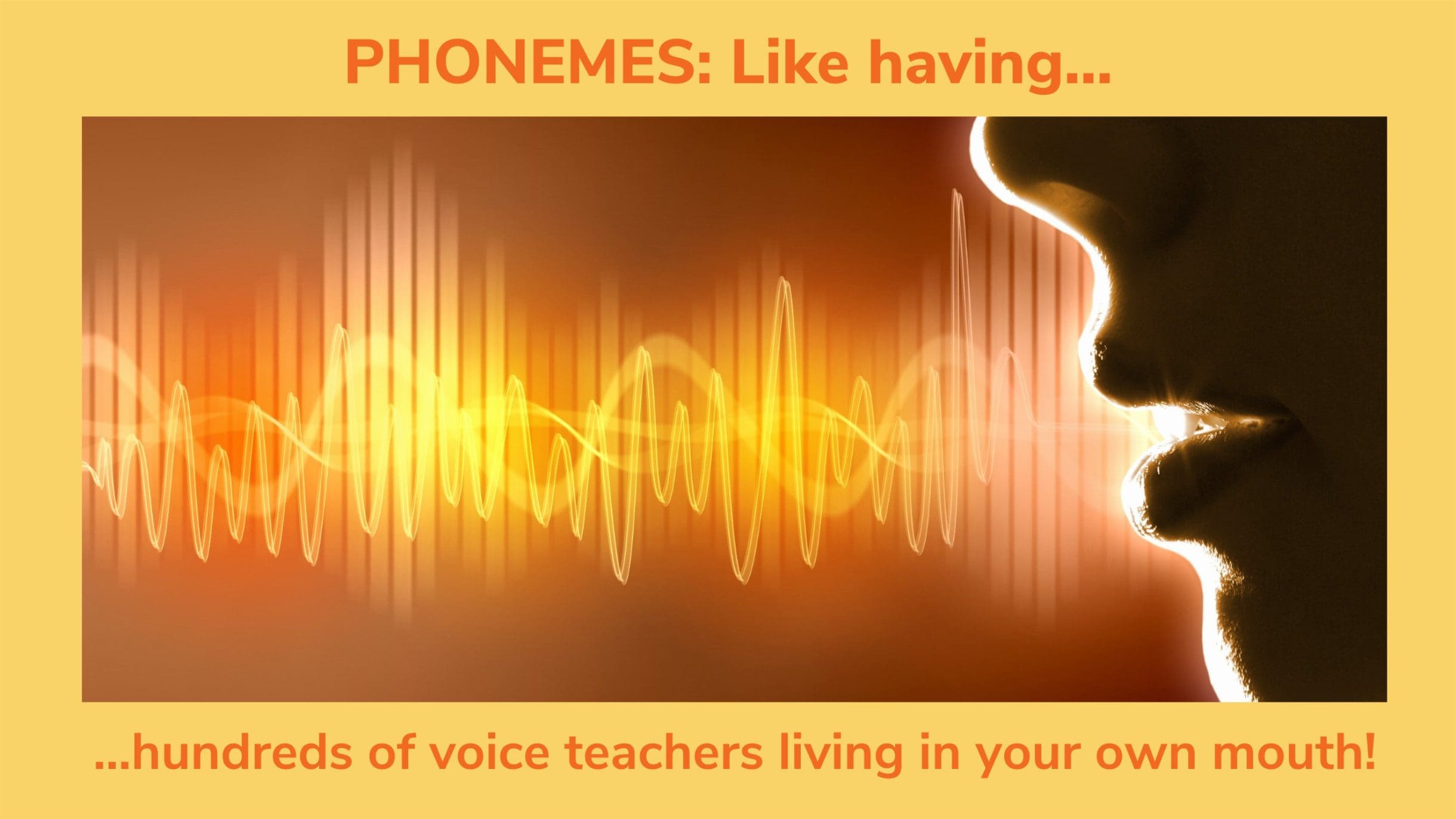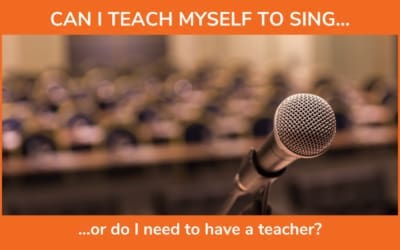Whether you’re a singer or a voice teacher, if you haven’t gotten into phonemes yet, you’re missing out. They are seemingly simple, perhaps inconsequential, yet used in the right way they can reveal previously unknown worlds of vocal learning! I swear.
When combined with awareness, phonemes hold secret powers to organize and reorganize our entire vocal system!
Oh, wait, maybe you don’t even know what a phoneme is? Or maybe you think it’s just about diction. Fear not… I’ll break it down for you RIGHT NOW!
WHAT IS A PHONEME?
A phoneme is the smallest unit of sound there is. One pure sound. They are like the basic building blocks of language. Each one distinct and unique.
A phoneme is the smallest unit of sound there is. One pure sound. They are like the basic building blocks of language. Each one distinct and unique.
Robert Sussuma
We can divide language this way. Paragraph –> Phrase –> Word –> Syllable –> Phoneme. That’s it. No smaller.
And, there are so many. Take the word: “flustered” (in American English). It’s one word, 2 syllables, 8 phonemes. 8 PHONEMES! f-l-uh-s-t-oe-r-d. (It’s awkward to write it out this way, but that’s why we have IPA – the International Phonetic Alphabet – look it up! In IPA it would be written something like: [ˈflʌstərd].)
In IPA, every distinct single sound (phoneme) that we can make with the human vocal tract has a symbol and there are many many many phonemes… Why? Because there are so many possibilities.
And different languages have different sets and variations of phonemes to work with. If this is a rabbit hole you’d like to go down, start here: https://en.wikipedia.org/wiki/Phoneme and go to town!
But, wait! There’s more!
BEYOND DICTION
Most voice/performance people think that learning about and working with phonemes is all about improving one’s diction or pronunciation/enunciation to be understood better or sound more authentic in performance.
I first got into phonemes and IPA back in college as a voice major. We took 4 semesters of diction class. If I recall correctly (it was $# years ago now…)
- Semester 1: English (British and American) Diction.
- Semester 2: Italian Diction.
- Semester 3: French Diction.
- Semester 4: German, Spanish, Russian and more.
However it was broken down, we did all of that in 2 years. We learned how to listen to words in various languages and transcribe them into IPA so that we could pronounce them well and we also learned some of the pronunciation rules of each language so that we could see the words written down in a score and figure out how they were pronounced – even if we couldn’t speak the language!
It was like having a magic power! It was a blast and served me well as a singer. And still does! Although I don’t use it so much for performing any more, it has definitely helped me learn other languages and pronounce people’s names more authentically! (That’s important to me!)
PHONEMES FOR LEARNING
BUT, the real magic of phonemes, I think, is in their power to teach us how to speak and sing better! They are literally like little voice teachers living in our own vocal tract! After all, they are how we all started to learn to speak in the first place, as babies.
Phonemes are literally like little voice teachers living in our own vocal tract! After all, they are how we all started to learn to speak in the first place, as babies.
Robert Sussuma
When babies and young children (way before they can form words and speak) are playing with pure sounds and phonemes, they are doing so in preparation for language acquisition.
We all, regardless of culture and languages heard around us, also start out with the same basic phonemes, variations of: m, b, n, ng, k, g, p and proto vowels. (They’re pretty universal before branching off into the particulars.) And when we get comfortable with these we start repeating them (reduplicative babbling) and stringing them together in various combinations (babbling).
All of this is a kind of preparation for speaking and the sounds and vocal movements help our brain/mouth/sound connection develop so that we can begin to form words and convey meaning, eventually. Because, without phonemes there is no language. But, sadly, once we get good at talking, most of us forget about the humble phonemes that make it all possible!

Returning to working with just phonemes and babbling as adults can actually help us go back and keep learning in this developmental way, even though we can already speak. Why is this important? Well, maybe we didn’t spend enough time with some phonemes? Maybe we skipped some? Maybe we can do them, but we don’t know how? Maybe we need to learn new ones for new languages or accents and they just aren’t in our repertoire yet?
But, really, we can also use them to improve the way our voices function? And, I say… we should!
What I like to do is use phonemes for pure vocal learning.
Here’s an example:
- Open your mouth comfortably.
- Bring your tongue to the part of the hard palate just behind and above the inside of the upper front teeth (the alveolar ridge).
- Keep the front of your tongue there and breathe for a while.
- Now, next time you exhale, leaving your tongue in this position, turn your voice on.
- What sound do you get? Which phoneme?
- Is it a vowel or a consonant?
- If it’s a consonant, which one?
- Is it one you recognize or not?
- It could be a few different ones depending on where your tongue is and some other variables.
- Is it an /n/ sound? /l/? /z/? Or something else.
- It could just be a consonant-like sound.
Play around with all of the possibilities…
Then, pick one that you recognize and try some variations:
- How far forward or back could you move your tongue and still create that phoneme?
- How far to the left or right could you have your tongue on the palate or teeth until it becomes a different sound?
- How many different ways can you make the same basic phoneme before it changes to another?
These are called allophones, by the way, and are very fun to play with – and very instructive. A phoneme/allophone exploration is like a movement lesson related to sound!
Anyhow, we could go on and on from here… but… hopefully you see the point I’m trying to make: We use phonemes all the time, but are we really aware of what they are and how we create them? And if we become more aware of, in, and through them, we can use them to improve our vocal abilities!
PHONEMES FOR CREATING VOCAL QUALITIES
This is where it gets interesting:
One phoneme:
You can take one phoneme and use it to create/clarify a vocal set up that can then be generalized to all other sounds. For example, sing a song. Now sing that same song – the melody – on one voiced phoneme such as “th” (/ð/) or “v” (/v/) or “l” (/l/). Do that a few times. Let it settle in.
Notice the shape it puts your mouth/throat into. Then sing – words and all.
How has your overall sound been influenced by that phoneme and shape?
Try the others. Notice how each one brings a different shape and different configuration that is carried over (generalized) to your “normal” singing. Each one has a tendency to bring about a particular shift. Once you know what those are, you can begin to use that as an in-mouth teaching device.
The phoneme shows you the way, and after spending time there, your brain takes that and uses it to integrate something new and useful for your vocal function.
And, guess what… it works with combinations:
Trying singing now where every syllable is a combo of phonemes like…
“fun” or “punk” or “grusk”
Do that for a while and then just sing and see what’s happened?
(You could also go phrase by phrase if that makes it clearer.)
The possibilities are ENDLESS… So play!
HOOKED ON PHONEMES
In THE SINGING SELF PROGRAM AND TEACHER TRACK we are definitely hooked on phonemes. They feature prominently in many of my lessons and classes for all of the reasons above and also because in the age of tele-learning phonemes do the teaching (they’re reliable and concrete) while I do the guiding and ask awareness questions to facilitate the learning. It works like a charm!
In fact, I have a whole series devoted to this topic called PHENOMENAL PHONEMES and in the TEACHER TRACK, TEACH WITHOUT TEACHING II is dedicated to (among other important strategies) how to use phonemes for vocal learning facilitation – it’s creative, fun and VERY effective!
Happy Phoneming Pholks!
This article is one of a series on the topic of the tongue and how it fits in with vocal learning. Read all about it here:
OH THE TONGUE!: THE CENTER OF IT ALL?





0 Comments